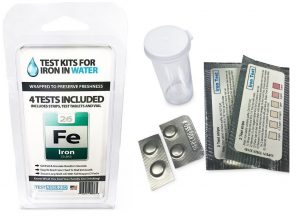
Iron in Water
A tall glass of cold water should be refreshing, but it can be unappetizing if it’s cloudy or comes with an unpleasant smell. Muddy looking water with a noticeable odor can be an indication of high iron levels, but contamination is not always easily visible. The only way to know what is in your water is to test it.
How Does Iron Get in Water?
The chemical element iron is a metal that naturally exists in the body and throughout the environment. Rivers, lakes, and underground water sources all contain trace amounts of iron. Sometimes iron is released into water supplies through industrial waste, refining of iron ore, corrosion of iron, and seepage from natural deposits.
When rain falls, or snow melts, it travels through the ground where there are iron deposits within the soil. The iron mixes with the water and both substances travel to underground aquifers which feed public and private water sources of drinking water.
Iron also leaches into drinking water from casings and pipes in plumbing systems. When water comes in contact with the iron, it begins to corrode. You may notice this corrosion as rust around your pipes. When the rust flakes off the pipes it falls into the water, increasing the iron levels of the water that comes out of your tap.
How to Test for Iron in Water
If your water is cloudy, yellow, or has a reddish-brown tint, you might want to check your iron levels. Iron is seldom found in water at levels that pose a health risk, but high levels of iron can cause an unpleasant taste and leave unsightly stains and deposits on fixtures and appliances.
Laboratories offer a number of convenient testing options to determine the amount of iron in your water. Depending on the location of the lab you choose, they may come to your house to test your water, or you may have to collect samples and mail them to the lab. Laboratory testing is a convenient way to get precise analysis of the exact amount of lead your water contains.
It’s also very easy to test the iron levels in your water on your own. You can purchase an iron test kit online or from your local home improvement store. TestAssured offers an easy to use iron test kit that will show you how much iron is in your water.
 To perform the iron test:
To perform the iron test:
- Remove the iron reagent tablet from the foil packet and place it in the test vial. Fill the vial with the water sample to within a ¼ inch of the top.
- Place the cap on the test vial and shake for approximately one minute, until the tablet is completely dissolved.
- Remove the test strip from the packet.
- Dip the strip in the sample for 2 seconds.
- Shake the strip once and wait 60 seconds.
- Place the strip on the results color chart to determine the amount of iron in the sample.
What are the safe iron levels that you can have in your water?
The Environmental Protection Agency has classified iron under the Secondary Maximum Contaminant Level standards. This limits the amount of iron in drinking water to a maximum of 0.3 milligrams of iron per liter. When water conforms to this standard, it will not be cloudy or have an unpleasant taste or odor and should not cause any adverse health side effects.
Iron is considered a non-threatening nuisance chemical according to the EPA standards:
| Iron Level | EPA Standard |
|---|---|
| 0.3 mg/l | Desirable level |
| 1.0 mg/l | Highest permissible level, anything greater could cause adverse health issues |
Is Iron in Your Water a Health Hazard?
The presence of iron in your water does not pose an immediate health risk. Increased iron levels may have unpleasant side effects such as fatigue, weakness, abdominal and bowel pain, nausea, cramping, vomiting, and constipation.
It is a good idea to maintain safe iron levels because some pathogens that can be harmful to the health of humans need iron to survive. When iron is present under this circumstance, it can be difficult to eliminate the bacteria.
Iron bacteria feed on excess levels of iron in drinking water and can leave behind iron waste deposits. These deposits are what cause your water to smell, and they can stain your fixtures. They also cause water to have an unpleasant taste. Additionally, iron bacteria emit a slime that may attract more dangerous bacteria.
While iron in your water isn’t a health hazard, it can contribute to a number of issues. If your water is cloudy, smells bad, or tastes funny, the first thing you should test for is iron.
